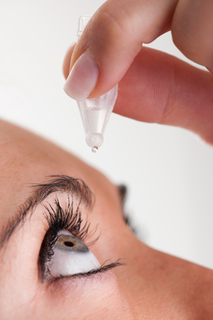Staying Alive: Saving Retinal Cells to Preserve Vision
Science Education
Sometimes, saving vision simply comes down to keeping retinal cells alive, or at least slowing their degeneration.

Some neuroprotective therapies may be delivered by eye drops.
Researchers are developing a number of promising treatment approaches for blinding retinal diseases, which include: correcting genetic defects; replacing lost retinal cells with new ones; and implanting electronic chips, like the recently FDA-approved Argus II. But, sometimes, saving vision simply comes down to keeping retinal cells alive, or at least slowing their degeneration. Known as “neuroprotection,” this approach isn’t just for the retina — it has the potential to preserve and protect all kinds of neural cells, including brain tissue and cells of the central nervous system.
What’s signficant about many emerging neuroprotective therapies for the retina is that they have the potential to treat a wide range of diseases, regardless of the genetic mutation causing vision loss. With about 200 genes linked to retinal diseases, this is a huge plus. They might also be used in conjunction with a genetic therapy to enhance its vision-saving effects.
Though neuroprotection usually isn’t addressing the root cause of the disease, it may be nearly as beneficial as a permanent fix, if useful vision can be saved for a person’s lifetime.
Neuroprotective treatments are being developed in many forms — proteins, drugs (small molecules) and nutrients. And there are several ways to get a neuroprotective therapy to the retina, including eye drops and oral medications.
Imagine having a therapy factory in the retina — in the forms of transplanted cells or genes — that provides continual release of neuroprotective proteins. Well, researchers are working on those, too.
Here are three examples of emerging neuroprotective therapies for the retina:
Protecting Mitochondria — MitoChem Therapeutics, a Foundation-funded start-up company, has identified two compounds, which show potential for saving vision for people affected by several retinal diseases, including retinitis pigmentosa (RP), cone-rod dystrophy, Bardet-Biedl syndrome, Usher syndrome, Stargardt disease and age-related macular degeneration (AMD).
The compounds work by protecting mitochondria, the power supplies for all cells in the body, including those in the retina. Investigators have refined the compounds to the point where they save virtually all of the photoreceptors in a mouse model of retinal degeneration. They’ve also demonstrated that eye drops can effectively deliver large amounts of one compound to retinas in eyes comparable in size to those in humans. Eye drops are beneficial, because they minimize potential systemic side effects.
Docosahexaenoic Acid (DHA) — DHA is an important structural component of cells in the brain and the retina. It appears to have many neuroprotective properties and is prescribed for a variety of conditions, including heart disease. Perhaps most relevant to retinal degenerative diseases, DHA can reduce the destructive effects of inflammation and oxidative stress. It also helps maintain the structure and metabolism of photoreceptors.
The Retina Foundation of the Southwest is completing a Foundation-funded clinical study of DHA for males with X-linked RP. Previous clinical studies conducted by Dr. Eliot Berson show that vitamin A combined with DHA can slow vision loss in people with RP. In 2014, the National Eye Institute will complete a clinical study of DHA and other nutrients for people at risk of advanced AMD. DHA can be obtained by eating salmon, tuna and other coldwater fish, or by taking fish-oil or algae supplements.
Rod-Derived Cone Viability Factor (RdCVF) — Drs. José Sahel and Thierry Léveillard, of the Institut de la Vision in Paris, received the Foundation’s Trustee Award for their discovery of Rod-derived Cone Viability Factor (RdCVF), a protein that preserves and rescues cones, the cells in the retina that provide central and color vision. They are now developing a gene therapy that provides sustained delivery of RdCVF after a single treatment. The protein could be beneficial to people affected by a broad range of retinal diseases, including several forms of retinitis pigmentosa. With Foundation funding, the researchers are working to move their RdCVF gene therapy into a clinical trial.
There are several other emerging neuroprotective therapies in the Foundation’s research portfolio. Stay tuned to Eye on the Cure and the Foundation’s website for updates on these emerging cross-cutting treatments.




